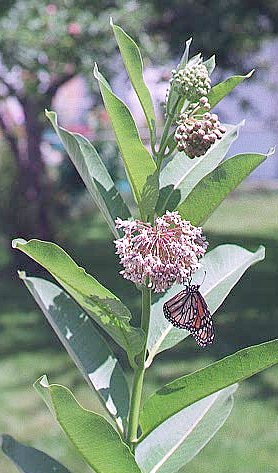


|
|
Common milkweed is the favorite of monarch butterflies. Its a perennial that's pretty common, usually 2-3 feet high but a guidebook says it will go to 6 feet. Mine didn't read the guidebook as its now taller than me making it probably nearly 7 feet. Don't confuse this with prarie milkweed. Prairie milkweed has leaves that attach directly to the stem of the plant while common milkweed leaves have a short stem.
Monarch butterflies lay their eggs on these plants so by growing some you end up increasing the butterfly population. Butterflies also favor the nectar found in the flowers. Take care not to place the plants near other plants that you you use pesticides on. Here are a couple of sites that describe how to raise monarchs:
The oleander aphid (see photo from TAMU) likes swamp milkweed and butterfly weed. I've also found them on Heliopsis helianthoides. These bugs start out as yellow-orange eggs mostly on the stems in clusters, they then develop legs that poke through the eggs, eventually the egg is absorbed into the bug and you're left with a small black fly. They do not seem to hurt butterfly weed however I think maybe a large concentration of them will hurt swamp milkweed and cause the leaves to wilt. You can squish large concentrations of the bugs with your fingers or hit them with a strong stream of water or both. How many I get on my plants varies, in 1999 I had a lot, 2000 there were very few.
The plant forms rough looking seed pods that eventually burst open and because they have a cottony dandelion-seed-like parachute they will blow all over the place. If you want to preserve all your seeds you can tie a string around the seed pod or something like a piece of a nylon stocking will do.
Seeds require cold treatment and light to germinate, see How to Start Seeds for details.